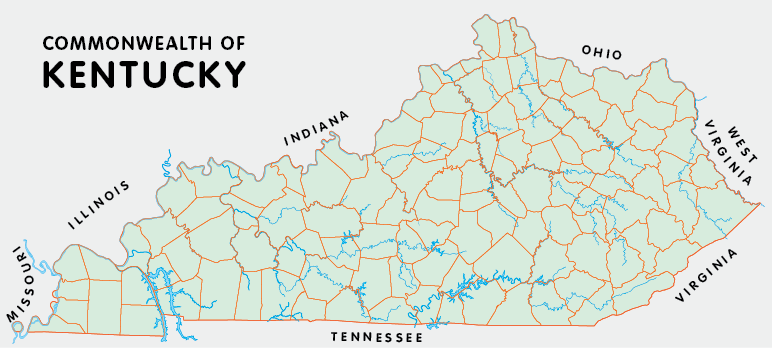
Select a county from the map for more information or see the
counties summary.
Relief
and
physiographic
maps are also available.
The Commonwealth of Kentucky is located in the central United States, bounded by the Mississippi and Ohio Rivers on the west; the Ohio River on the north; the Big Sandy River, Pine Mountain, and Cumberland Mountain on the east; and the state of Tennessee on the south.
In 2020 it had a population of 4,505,836 in a land area of 39,486 square miles, a mean of 114 people per square mile.
The capital of Kentucky is Frankfort in Franklin county in the central part of the state. Kentucky is divided into 120 counties which contain numerous incorporated cities. Lexington and Fayette county and Louisville and Jefferson county have merged city-county governments. They are also the largest cities in the state.
Several statistical areas – metropolitan and micropolitan areas – are defined by the U.S. government within or extending into Kentucky.
Kentucky is also divided into fifteen multi-county Area Development Districts.
Kentucky has an extensive system of State Parks and Nature Preserves and has several National Parks and reserves.
Once part of Virginia, the land that is now Kentucky was formed into Kentucke county, Virginia in 1776. Four years later it was divided into the Fayette, Jefferson, and Lincoln counties of Virginia. It became the fifteenth of the United States in 1792. The name Kentucky is of Native American origin and has been attributed to several languages with several possible meanings from “land of tomorrow” to “cane and turkey lands” to “meadow lands.” This last may come from the Iroquois name for the Shawnee town Eskippathiki. The name Kentucky referred originally to the Kentucky River and from that came the name of the region.
The use of “commonwealth” in the name Commonwealth of Kentucky doesn’t have any particular significance – it means the same thing as “state” and was commonly used in the eighteenth century. Kentucky probably used it since it was formed from Virginia, which had used it earlier. Pennsylvania and Massachusetts also use commonwealth. The colonial use of commonwealth probably derives from the Commonwealth period in England and sometimes was used to distinguish royal colonies from the proprietary colonies. The term is now also used to designate autonomous areas associated with the United States, such as the Commonwealth of Puerto Rico.
KENTUCKY GEOGRAPHY AND GEOLOGY
Kentucky can be divided into three parts – the eastern mountains, the interior, and the Mississippi plains in the west. These large areas can be divided into several physiographic regions. The eastern end of the state is known as the Eastern Coal Field. The Appalachian Mountains extend into the state here and the highest point in Kentucky, Big Black Mountain, 4,145 feet above sea level, is here in Harlan county. The western end of this region is known as the Cumberland Plateau which extends west to the Pottsville Escarpment and the eastern Knobs, which divide eastern Kentucky from the rolling hills of the Bluegrass.
The Bluegrass is ringed by the knobs on the east, south, and west and by the Ohio river on the north. The largest cities, Louisville and Lexington, are located here. The Inner Bluegrass is centered around Lexington and is known for its rich soils, a result of the limestone which lies near the surface in many places and can be dramatically seen in the Palisades along the Kentucky river.
To the south and west of the Bluegrass is the Pennyrile (or Pennyroyal). It extends west to the Cumberland and Tennessee rivers (now Lake Barkley and Kentucky Lake) and includes a large karst area that includes Mammoth Cave. Surrounded by the Pennyrile and the Ohio river is the Western Coal Field, part of a large coal-bearing region that extends into Indiana and Illinois. West of the lakes is the Jackson Purchase, which is bordered by the Ohio and Mississippi rivers and consists mainly of flat, alluvial lands. The lowest point in Kentucky, in southwestern Fulton county, 250 feet above sea level, is here.

Generalized Geologic Map of Kentucky (Kentucky Geological Survey, 1979)
Iron ore is found in several places in the state and Kentucky was a major iron producer in the nineteenth century.
The Kentucky Geological Survey has more information about the geology of Kentucky.
More Kentucky facts are available along with a list of selected place names.
SEARCH THE KENTUCKY ATLAS & GAZETTEER
© 2026 David C. Elbon

